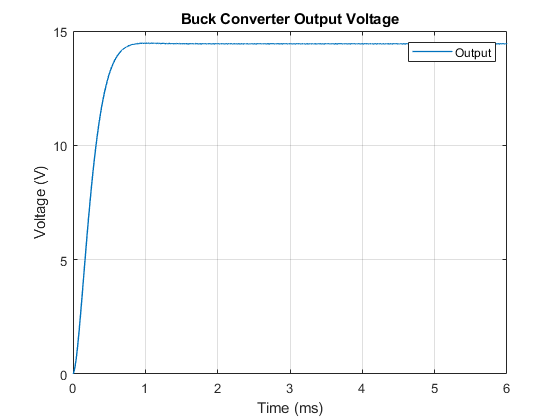Analysis of Synchronous Buck Converter with Self Turn-On
This example analyzes the self turn-on mechanism in a synchronous buck converter. When the low-side MOSFET Q2 is off and the high-side MOSFET Q1 turns on, a current flows through the gate-drain capacitance of Q2 due to the voltage ramp dv/dt between the drain and source of Q2. This current induces a voltage across the gate and source of Q2. If the voltage exceeds the threshold voltage, Q2 unintentionally turns on. This example shows how the MOSFET parameters affect the self turn-on mechanism and how you can prevent it.
Synchronous Buck Converter Overview

Simulation of Output Voltage and Self Turn-On
The plots below show the output voltage of the buck converter and illustrate the self turn-on mechanism of Q2. The duty cycle of the model is equal to 50%. In this example, to demonstrate the self turn-on phenomenon, the gate resistance is very high. Q2 self turns on at the rising edge of the gate source voltage of Q1.


Effect of Gate Resistance on High-Side MOSFET Q1
When Q1 turns on, its gate resistance affects the slope of the drain-source voltage of Q2. The higher gate resistance results in a lower slope rate of the drain-source voltage and reduces the occurrences of self turn-on for Q2.

Effect of Gate Resistance on Low-Side MOSFET Q2
The gate resistance of Q2 is directly proportional to its peak gate and to the time required to discharge the gate charge.

Effect of Gate Drain Capacitance of Low-Side MOSFET Q2
The current that flows through the gate-drain capacitance, Cgd, of Q2 is proportional to the gate-drain capacitance value. A small Cgd helps preventing the self turn-on mechanism of a low-side MOSFET.

Effect of Gate Source Capacitance of Low-Side MOSFET Q2
A high value of the gate-source capacitance, Cgs, decreases the peak gate source voltage of Q2 and increases the time required to discharge the gate charge. To prevent the self turn-on mechanism, as the gate-source voltage of Q2 is proportional to Cgd/(Cgs+Cgd), use a MOSFET with low Cgd/Cgs ratio. However, high values of the gate-source capacitance reduce the switching speed.

Method of Preventing the Self Turn-On Mechanism
To prevent the MOSFET self turn-on mechanism, you should implement MOSFETs with high threshold voltage, low gate drain capacitance, and low gate drain to gate source capacitance ratio. You can add a capacitor between the gate and the source of the MOSFET to further reduce the Cgd/Cgs ratio.
